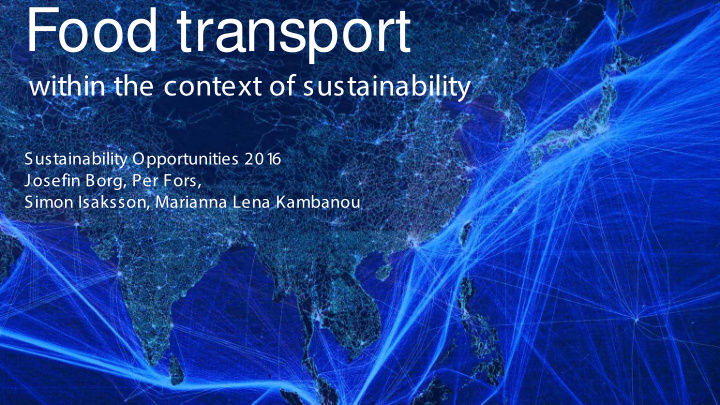



Food transport within the context of sustainability Sustainability Opportunities 201 6 Josefin Borg, Per Fors, Simon Isaksson, Marianna Lena Kambanou
Overview To explore the comprehensive challenges associated with food transport from the perspective of sustainability’s three dimensions: environmental, social and economic � literature review of challenges � 2 case studies (banana & coffee) � discussion “ Fo o d mile s ” the dis tanc e that fo o d has trave lle d b e tw e e n pro duc tio n and c o ns umptio n � solutions - opportunities
Sustainability Challenges
Three main drivers for food transportation 1 . Regional production price differences E.g. meat and dairy products produced in New Zealand, supplying North Atlantic economies 2. Movement of seasonal crops between hemispheres E.g. citrus and deciduous fruits from South Africa transported to the Northern hemisphere during its winter season 3. Climatic differences E.g. bananas
Food transport UK in 2002 A ccounted for around 30 billion vehicle kilometers 82% of these were within the UK Road vehicles dominating Food tonne kilometers would change the figures 1 992-2002: Air freight grew with 1 40% Vehicle-kilometers by transport mode for UK food market in 2002. LGV = Light Goods Still only 0.1 % of vehicle kilometers or 1 % of Vehicle. HGV = Heavy Goods Vehicle. food tonne kilometers Source DEFRA 2005
Food transport UK in 2002 Vehicle-kilometers by transport mode for UK UK food transport related CO2 emissions in food market in 2002. LGV = Light Goods 2002. LGV = Light Goods Vehicle. Vehicle. HGV = Heavy Goods Vehicle. HGV = Heavy Goods Vehicle. Source DEFRA 2005 Source DEFRA 2005
World trade in perishable food stuffs (mt) Development perishable foodstuffs' world trade (mt), 1983-2005. Source: Stopford 2009 (with data from FAO)
Three types of refrigerated cargo Frozen cargo Fully frozen, temperatures up to -26°C E.g. meat and fish Chilled cargo Low temperatures but above freezing point E.g. dairy products and other perishables Controlled temperatures b d f d d
Capacity reefer fleet and reefer container development (1 980 - 2007) Source: Clarkson Research Reefer and Container registers (from Stopford, 2009)
Case studies Comparing transportation of bananas and coffee � Case comparison ○ Similarities � Kind of food product � Transportation route ○ Differences � Product chain � Processing � Impact from transport Source: https://en.wikipedia.org/wiki/Timeline_of_world_map_changes#/media/File:BlankMap-World.png � Mode of transportation
Case studies Comparing transportation of bananas and coffee Sustainability considerations Environmental Mode of transportation Waste due to spoiled produce Economic Tariffs, import licenses, free trade Social
Discussion Food transport is part of the sustainability discussion for both food ood and trans nspo port . Sustainability is unk unkno nown and ver ery c complex ex Efficiency, lifecycle perspective, context, labour conditions both nega gativ ive and posit itiv ive sustainability dimensions nega gativ ive e.g. ghg emissions, fuel consumption, loss of local jobs, animal cruelty, higher chance of human rights violation posit itiv ive e.g. cities as health promoters, accessible and culturally acceptable food, variety, aid work
Sustainability opportunities lopments � Fossil free transport � Climatic, water, cultural & economic Major � Climate resistant assessments of food production & infrastructure processing potential of areas to develo substitute purely financial criteria l de � Better refrigeration � Rethink luxury and necessity gical technology � Fair trade as standard practice logic Incremental � Packaging globally Technolo � Better tracking systems � Prohibit food air-transport � Building up of infrastructure in developing countries Incremental Major Socio-ec So economic d dev evel elopmen ents
Food transport within the context of sustainability Sustainability Opportunities 201 6 Josefin Borg, Per Fors, Simon Isaksson, Marianna Lena Kambanou
Recommend
More recommend